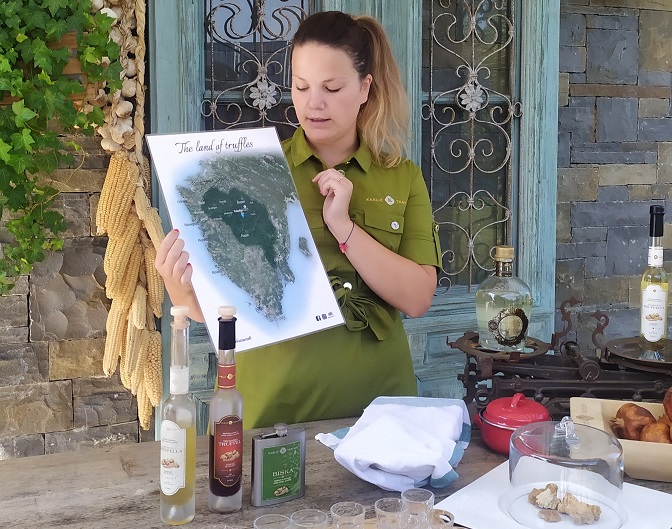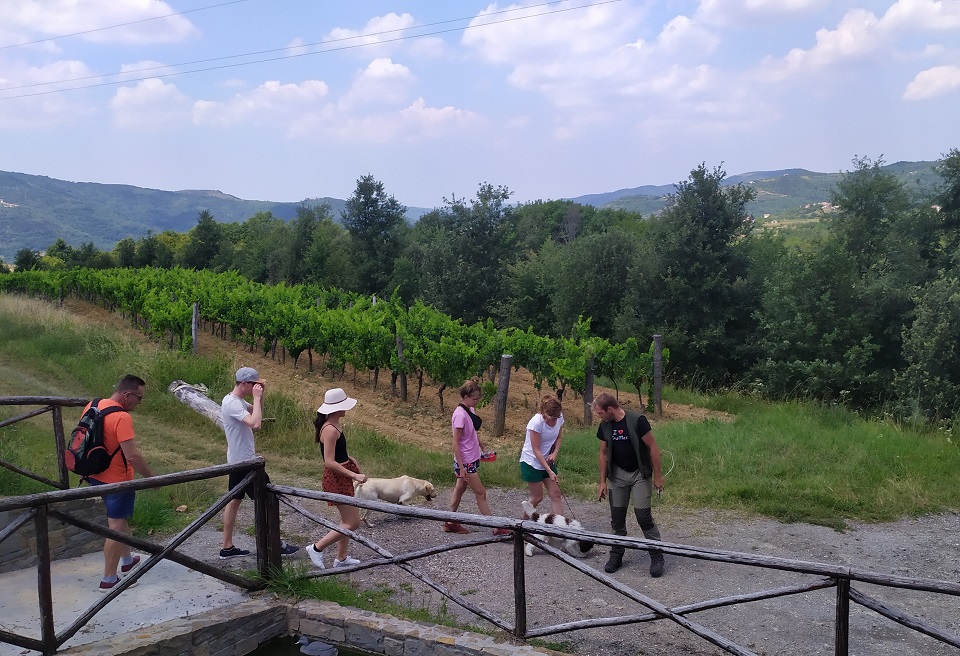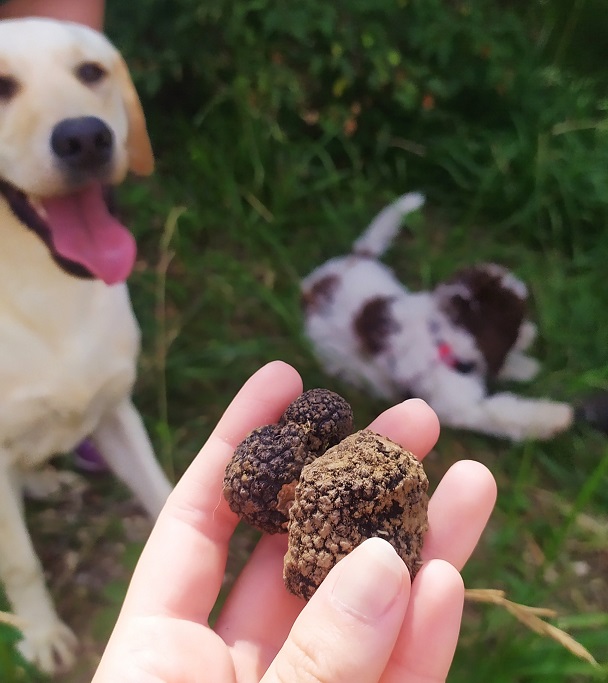July 24, 2020 - The Karlić family was the first in Croatia to offer visitors the experience of truffle hunting. We headed out on this unique and above all demanding activity with a truffle hunter and a dog Lila that has been specially trained to search for truffles. In addition to the experience of hunting on the property of the Karlić family, the tour also included tasting specialties with truffles, and owner Ivana prepared them in front of us.
A small number of people in Croatia are engaged in the production of truffle products. The Karlić family is one of the few families in Istria that is more seriously engaged in their production and distribution, but also in hunting. Interestingly, because of local peoples’ tradition, it is said truffle “hunting”, not harvesting.
More dogs than humans
Truffles in Croatia grow mainly in central Istria, and in the rest of the world, they can be found in Italy and small quantities in France, Germany, Austria, and some other countries. They are mostly used by people in Italy and Croatia.
The Karlić family started their story about truffles when their grandfather started researching them 40 years ago. He quickly passed this love on to his wife and daughter, Ivana's mother. It was strange because, at that time, she was supposed to have a "female“ job, not be in the woods with other guys, but she didn't care. Later, she started a family business. Her children Ivan and Ivana also literally grew up in the woods truffle hunting.
At the entrance to a beautifully landscaped yard in the small central Istrian village of Paladini, I and a few other visitors were greeted by Ivana Karlić together with their seven truffle hunting dogs. She explained that there are more dogs than people living in Paladini, located a 40-minute drive from Poreč. There are only about 40 inhabitants, and about 100 dogs because all the people there are engaged in truffle hunting.

Ivana Karić introduced us to the Istrian tradition of truffle hunting
I was enchanted by the large tasting room for sampling truffles, which perfectly fits in with the nature of central Istria. The panoramic view of the surroundings of Motovun leaves you breathless, as well as the truffle specialties prepared in front of you by Ivana.
Demand for truffles
At the beginning of the truffle hunting tour, Ivana introduced us to the family tradition and we "warmed up“ by tasting homemade truffle rakia – Biska, Teranino, and Medenica.
You can't go truffle hunting in the woods on an empty stomach, so three sequences of dishes followed – slices of sausage and cheese, scrambled eggs, and candied fritters. All the specialties were extremely delicious and filling. That's why it is advised to come hungry. Ivana prepared all the specialties for us in the open kitchen in the tasting room. We could see the whole process of preparing and cooking dishes with truffles. While she was cooking and serving us, Ivana was casually telling the story about truffles and her family.
Truffles and truffle products such as oil, cheese, sausages, rakia, and even chocolate spread can be bought at the shop on the property. Recently they even opened a store in Poreč.
The idea of opening a store came up during self-isolation when they finally had time to think about it, plan it, and realize it. Until now, their products could have only been bought on their property, and their truffles were found in the dishes of many Istrian restaurants, most of which are in Poreč.
"We opted for Poreč because we cooperate with a large number of restaurants here. A lot of people who eat in these restaurants want to buy truffles, but they don't want to come to Paladini only to buy them, so we thought it was a perfect opportunity for guests to buy truffles and take them home,“ says Ivana.
Also, during the lockdown, when they were forced to stay home, and also when the amount of work in tourism was much smaller, they opened an online store to sell their products.
Truffle shop in the Istrian city of Poreč
Training dogs (and people) to truffle hunt
After Ivana fed us well, we went hunting in the woods. Fifteen years ago, the Karlić family launched guided tours with truffle hunting dogs to give tourists a direct insight into how difficult it is to find truffles in the woods. The truffle is, in fact, an underground fungus that grows in symbiosis with trees, at their roots, most commonly oak and hazelnut trees. This makes them extremely difficult to find, so specially trained dogs are needed to search for them.
"Any dog breed can truffle hunt, but the best breed is the Italian Lagotto Romagnolo. They are very obedient and have a good sense of smell. It is easy to train them. Females are much better at truffle hunting because they are focused on truffle hunting all year round, while males are in one part of the year focused on looking for females and are therefore 'distracted',“ explains Ivana.
The Karlić family trains dogs too, as well as organizing courses and exams for future truffle hunters, as people who go truffle hunting are called.
"The training itself lasts one year. We are training them since they are 3 to 4 months old, through the game. We give them truffle treats, we bury truffles, we show them how to dig truffles... The last and most important learning process is the departure of a small puppy with an adult truffle hunting dog to hunt. An adult dog starts digging, gets a reward, a small dog is always jealous of it and then because of his jealousy he will start looking for truffles and get a reward for finding it,“ says Ivana and adds that they only train their dogs.
Karlić family has seven dogs and all of them must be trained every day
Truffle hunters must also pass an exam to know how to behave with dogs in the forest. The license is paid and every year the entrance to the Croatian forests for hunting white truffles must be paid separately.
"We organize exams for truffle hunters in our property. We have about 300 people looking for truffles for us and from whom we buy them,“ explains Ivana.
Kings of gastronomy
A smiling truffle hunter Sanjin, dressed like a real hunter with a small shovel on his shoulder, along with the dog Lila, took us to the woods. The real adventure began. It was great to feel the uncertainty in the search for truffles because every time you go to the forest you never know if you will find truffles.
One tourist took her dog on the tour, which is also allowed, so the hunting experience itself was even more fun as both dogs ran around us in search of truffles.
There are two main types of truffles, black and white. Black truffles grow throughout the year in Istria and are divided into two types – summer and winter. The summer truffle is most often used by restaurants and costs around 200 euros per kilo, but the price always varies, depending on supply and demand.
White truffles grow only from September to January. The peak of the white truffle season is in November and its price is much higher, ranging from 400 euros per kilo to 2,000 – 3,000 euros per kilo, depending on the size and details. With white truffles, every detail counts.
As Ivana says, the white truffle is the king of gastronomy. It is one of the top 10 foods in the world in terms of quality, price, and demand. It is expensive because it grows only in Italy in the area of the town Alba and the province of Umbria. In Istria, it grows in the Motovun forest near the largest Istrian lake Butoniga. That's exactly where we were truffle hunting too.
Commitment to work
The Karlić family was the first in Croatia who tried to cultivate black truffles – and they succeeded. Our truffle hunting tour started right from their black truffle plantation towards the forest. However, it took a lot of time for the first black truffle to grow there.
"It was a big experiment. We waited 8 years to find the first truffle. After 8 years, our hopes that black truffles can be cultivated have been confirmed. A lot of people after us also planted plantations. One would think we might be jealous because it was our idea, but we’re very proud. It favors afforestation and the environment gets cleaner,“ says Ivana, who believes that the cultivation of black truffles was helped by the fact that the plantation was planted quietly next to the forest where they grow naturally.
During the tour, our truffle hunter and guide Sanjin was tirelessly showing us how to truffle hunt. When a dog starts digging, it means he has scented something. When Lila started digging, Sanjin ran up to her to stop her from eating the truffle she found. By the end of the tour, Lila found three truffles, with a little help of one visitor's dog.
As the truffle maker explains, dogs must be in constant contact with truffles, eat them and go hunting for at least an hour every day, so during our tour he allowed him to eat one small truffle he dug up.
A small, well-coordinated team
Sometimes truffle hunting fails. Sometimes no truffles could be found, given that they are very rare and difficult to find, but this does not discourage truffle hunters at all. Sanjin says he goes truffle hunting as early in the morning as 4 am and it never gets boring.

Guided truffle hunting tour in the central Istria
Judging by what I experienced at their property and in the forest, the Karlić family, together with a few more employees, have dedicated their lives to truffles. Ivana is the third generation in the family of truffle hunters. As Ivana points out, the truffle business, from cultivating, hunting, cooking, production, distribution to selling products, is not considered a job at all but a way of life.
"Our team is not big, but it is well-coordinated. We are all like one big family and everyone knows how to do everything. Everyone loves dogs and truffles and it can be seen,“ says Ivana.
Most of the guests are foreign tourists
After spending a day on their property, I realized that the Karlić family members love what they do. Guests, mostly foreign tourists, also recognize it.
"Foreign tourists make up 90 percent of our tourists. For them, our products are affordable, some even say cheap, while for the average Croat our products are expensive, which is clear to me. Truffle hunting justifies our offer in terms of price,“ says Ivana.
An hour at the tasting hall and two more hours truffle hunting were enough to delight me.

Black truffles, straight out from the ground
"People have great food truffle hunting experience. Some people come back to us every time they come to Croatia. They go on the same tour, eat the same menu, only because they enjoy our hospitality,“ says Ivana.
If someone had told me that my most beautiful experience during the summer would be going to the forest to truffle hunting, I would not have believed him. But Ivana and her team managed to convey their love for truffles to all of us visitors.
What makes Karlić family so unique is their passion and unsurpassed knowledge about truffles.
Truffle products
Last year, the Karlić family, in cooperation with the Aura Distillery, launched the first truffle-flavored gin. It's limited edition and a one-liter bottle costs 100 euros. This gin sold out quickly, and as Ivana Karlić says, the price is so high because of the extreme complexity of its production, as well as the taste. Even critics say their gin is top-notch and deserves that price.
Also, the Karlić family was the first in the world to make a combination of chocolate spread and truffles. It resulted in Trufella, a version of Nutella with truffles, made of white and dark chocolate. It is also possible to taste and buy Truffela while on the truffle hunting tour.
“We also have cheese and sausages. We make such products in cooperation with other small manufacturers. We give them our truffles, they already have their well-known product and then we combine it,“ says Ivana, but adds that the best product is fresh truffles that can be added to any dish. She recommends it with traditional Istrian pasta called fuži.


